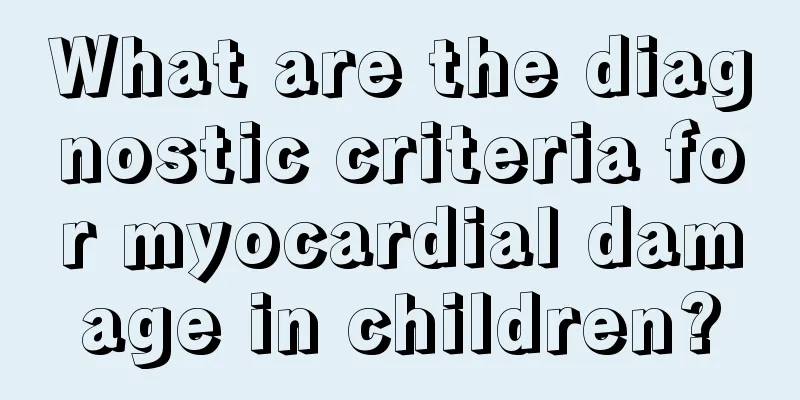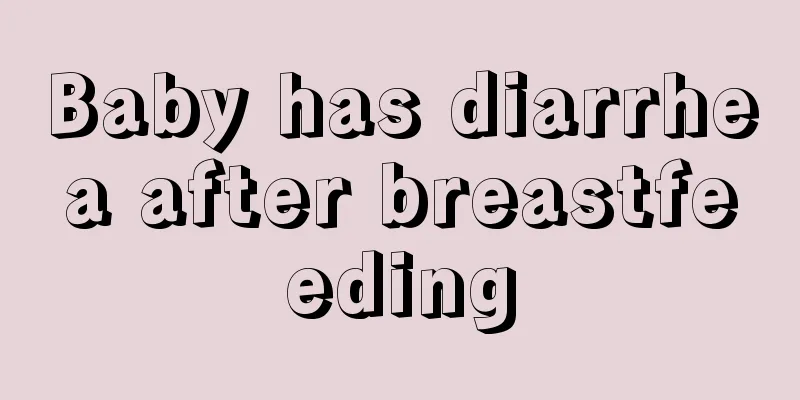What are the diagnostic criteria for myocardial damage in children?

|
Myocardial damage is a particularly serious disease for children. Generally, patients will show symptoms such as shortness of breath, pale complexion, chest tightness, and general fatigue. Some patients may also experience tachycardia or bradycardia. These symptoms are also the standard basis for diagnosing myocardial damage in children. If your baby has the above conditions, you must actively seek treatment to prevent the condition from worsening. 1. Diagnostic criteria for myocardial damage in children 1. Symptoms The main symptoms are long sighs, shortness of breath, and slightly pale complexion; some older children may complain of precordial discomfort, chest tightness, and fatigue after activities; or there may be no symptoms. (II) Physical signs There are no obvious positive signs. Cardiac examination usually shows no obvious abnormalities, the heart borders are normal, the heart sounds are strong, and some patients may have tachycardia, bradycardia, or premature beats. 3. Laboratory examination Serum myocardial enzymes (aspartate aminotransferase GOT, creatine phosphokinase CPK, creatine phosphokinase isoenzyme CK-MB, lactate dehydrogenase LDH) can all increase in the acute phase, but the increase of CPK and CK-MB is more meaningful for the diagnosis of myocardial injury. Serum troponin (Tn) is often negative. Electrocardiogram: Electrocardiogram changes of myocardial damage are non-specific, and various types of abnormal ECG manifestations may appear, but none of them are as severe as those of myocarditis: common mild T wave changes, ST segment deviation (limb leads <0.05mv< span="">, chest leads <0.1 mV), and QRS low voltage. There may be arrhythmias: such as occasional premature beats, type I0 or II0I atrioventricular block, intraventricular block and other milder ECG changes. (The ECG diagnostic criteria for myocarditis are: ST-T changes in 2 or more main leads (I, II, aVF, V5) dominated by R waves lasting for more than 4 days with dynamic changes, sinoatrial block, atrioventricular block, complete right or left bundle branch block, coupled rhythm, polymorphic, multi-source, paired or parallel premature beats, ectopic tachycardia caused by non-atrioventricular node and atrioventricular reentry, low voltage (except newborns) and abnormal Q waves.) Echocardiography shows normal heart structure and contractile function, and very small amount of pericardial effusion. 2. Treatment of infectious myocardial damage in children 1. General treatment: Those with symptoms can take oxygen appropriately; pay attention to rest and sleep; avoid repeated infections; reduce activities as much as possible, exempt school-age children from physical activities, and avoid infants and young children from crying violently; 2. Anti-infection treatment: For children with existing infections, active symptomatic anti-infection (bacteria, viruses, mycoplasma, etc.) treatment should be given. 3. Myocardial protection therapy: Provide myocardial energy and promote myocardial cell repair; the course of treatment is usually 3-6 months. (1) Western medicine: intravenous injection: sodium creatine phosphate (1g/time, twice a day), vitamin C (1-2g/day), etc.; Oral: sodium fructose diphosphate oral solution or capsules, coenzyme Q10, etc. (2) Traditional Chinese medicine: Qidong Yixin oral liquid, etc. 4. Follow-up observation: After 6 months of treatment, if the child still has unrecovered ECG changes and continued elevated myocardial enzymes (excluding infection and other inducing factors), it is necessary to complete ECG, Holter, echocardiography, treadmill exercise test, cardiac spiral CT, cardiac MRI and other examinations as appropriate to re-evaluate the child's condition, clarify myocardial disease and whether there is coronary artery disease, and further adjust treatment. |
<<: Does baby seborrheic dermatitis need treatment?
>>: What should I do if my child has abscesses?
Recommend
How to correct the uneven back of the baby's head
Some parents may find that the back of their baby...
How to prepare sea bass as baby food?
Sea bass is a very delicious food in our daily li...
What should I do if my child has lymphangioma?
Lymphangioma is a relatively rare disease clinica...
What to do if your child's front teeth are broken
Bumps and bruises are inevitable in life. Many ch...
What happened if my child suddenly has swelling under his ear?
When a child feels unwell, he or she will definit...
What to do with conjunctivitis in a three-year-old baby
When a three-year-old baby develops conjunctiviti...
What should babies eat if they have a bad stomach?
Some mothers are confused as to why their babies ...
Viral herpes stomatitis in children
Viral herpes stomatitis is more common among infa...
What happens if a child has transparent blisters on his body?
Blisters are a symptom of a viral infection. If b...
What should I do if my two and a half year old baby has a bad stomach?
The problem of a two-and-a-half-year-old baby hav...
Nutritious meals for 2-year-old babies
Many mothers are more concerned about the growth ...
How long does it take for a child to speak?
Each stage of a child's growth is gradual, an...
How to treat malnutrition in a 9-year-old
For parents, the biggest fear is the baby getting...
How should children with chronic heart disease be treated?
The birth of a baby is supposed to be a very happ...
What are the diets for children with autumn diarrhea?
Many people who have been parents may know that d...









